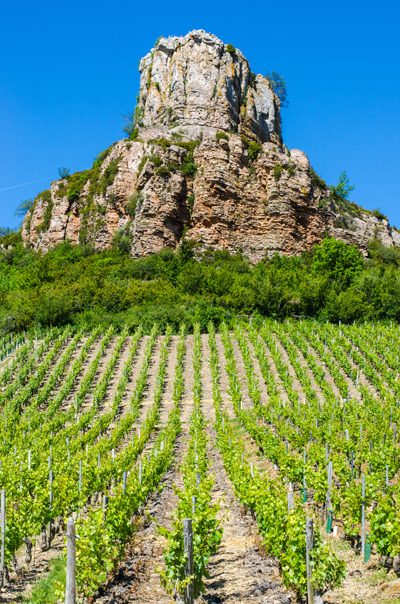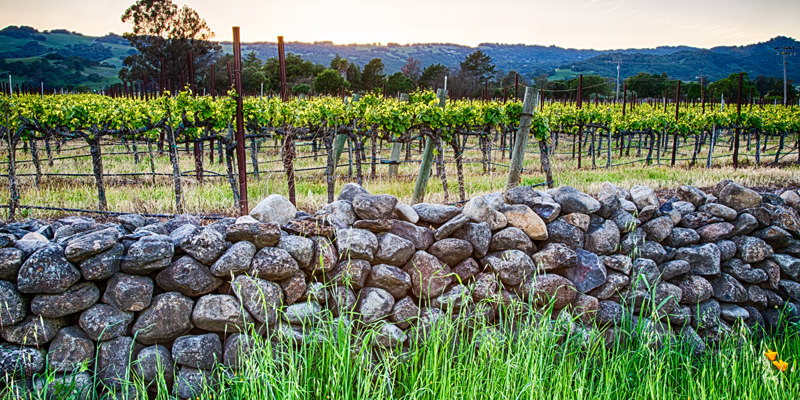If grape vines are babies, terroir-driven wines are the well-adjusted adult—flavorful, complex, and sometimes a little weird. Terroir is after all, that mysterious sense of place developed with each drop of rain, sunny day, hail storm and the rocks present in the soil.
Yes, rocks.
While wines don’t acquire minerality by slurping minerals from the rocks themselves, geology is the basis of soil composition which dictates how grapevines thrive in a given area. In essence, the bedrock of a region helps release nutrients in the topsoil, and determines water retention. Good or bad drainage, nutrient components, and the density of the soil—which ranges from heavy clay to fluffy dirt, sand, or gravel—combine in a grape growing cocktail that dictates what and how grape growers plant their vineyards. And that’s where geology comes in: tectonic activity, ancient oceans, and the movement of land masses millions of years ago have shaped today’s wine regions, and you can taste the results.
Named after the Jurassic Era, France’s tiny Jura region highlights the importance of geology in winemaking. Nestled between Burgundy and Switzerland, this tiny strip of land is mountainous and uneven, with stony peaks that leap up imposingly around small, well-manicured vines. Originally formed with shale, this area was bordered by a massive sea millions of years ago, which eventually withdrew and left a huge deposit, or graben, in the earth. This receding sea exposed layers of multicolored soils (and loads of dinosaur fossils) perfect for grape growing. Eventually, downward pressure toward this graben forced fault lines to emerge in the Jura, and some of these layers—clay, marl, and gravel—were forced upward in jagged, seemingly random areas amidst a limestone base.
As a result, Jurassic wines display a staggering array of diversity, especially considering it’s France’s smallest wine region. Chardonnay and Pinot Noir flourish on its limestone soils, which contribute acidity to resulting wines, while clay and marl (a mix of muddy clay and limestone) give native grapes like Poulsard, Trousseau, and Savagnin a place to thrive. The secret is that limestone is a basic component (on the pH scale), and thus provides acid in finished wines. Clay, on the other hand, retains water, and is dominated by other minerals like calcium carbonate. Combine that mix with interspersed areas of gravel and shale, and the geologic winemaking cocktail becomes increasingly complex, as do the wines.

Just across that ancient sea lies Burgundy, the long-adored home of France’s most valuable Pinot Noir and Chardonnay. Here, only limestone and bits of marl were exposed as the ancient sea gave way millions of years ago. A short drive from the Jura, the same limestone soils sharply define the cool-climate wines of Burgundy, giving them laser-sharp Chardonnays like Chablis and bright, ageable Pinot Noir. In contrast to the Jura, other grapes are not widely cultivated, and the relative homogeny of the limestone hills—where other component elements like chalk only make small appearances—make it possible to define minuscule vineyard plots by slight differences in their soil content, which led to the complicated Cru system in Burgundy today.
Sicily dramatically contrasts its Francophone neighbors, and doesn’t surprise vineyard managers with fossils. Instead, the island is characterized by rich volcanic soils that cover Mount Etna and its surrounding hills. Formed over millennia as the African continent pressed northward, Sicily rose from the Mediterranean Sea. Over millions of years, the volcanic ash that rained down on Sicily formed mineral-rich soil, combining elements like sulfur, iron, and magnesium. Because Mount Etna is an active volcano, new nutrients regularly rain down on the vineyards. This nutrient-dense soil can support nearly any grape variety, which led the island to produce high-yielding bulk wines for most of its history.
Today, a renewed focus on quality has covered the island. On these sunny slopes, classic Marsala (read: NOT the kind on grocery store shelves everywhere) and Nero d’Avola wines display ripe, fruity characteristics and a range of native white grapes are cultivated as well.

